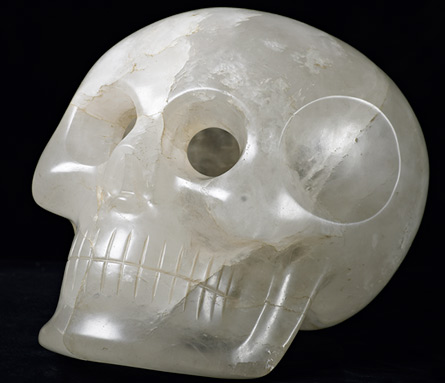They’re fake, Indy!
Two allegedly pre-Columbian crystal skulls turn out to be counterfeits
Welcome to this summer’s scientific blockbuster, “Indiana Jones and the Kingdom of the Crystal Skullduggery.” In his latest cinematic adventure, the bullwhip-cracking Jones chases down an ancient skull carved out of crystal that contains supernatural powers.

But a new analysis of two actual crystal skulls — skulls carved out of a type of quartz rock — fingers the artifacts as forgeries. The supposed treasures have been attributed to either the Aztecs or a related pre-Columbian society in Mexico, the Mixtecs.
One of the two life-size carvings was purchased in 1897 by the BritishMuseum in London and the other was delivered anonymously in 1992 to the Smithsonian Institution in Washington, D.C. Both these and other skulls liked them helped to inspire not just this weekend’s “Indiana Jones” movie but also public speculation about whether crystal skulls obtained by museums and collectors since the late 19th century originated on a long-lost continent or even in outer space.
“The BritishMuseum and Smithsonian skulls were carved with relatively modern stone-working equipment, which was unavailable to pre-Columbian stone carvers,” says Smithsonian anthropologist and study coauthor Jane Walsh.
A team led by Walsh and BritishMuseum archaeologist Margaret Sax published the findings online May 18 in the Journal of Archaeological Science.
Like all other crystal skulls, the BritishMuseum and Smithsonian pieces don’t come from documented excavations. Sax and her colleagues examined the fine detail of carved features on the skulls to determine what types of tools were used to make them. For comparison, they similarly assessed a Mixtec rock crystal goblet and five Aztec rock crystal beads that were excavated at sites dating from about 1,000 to 500 years ago.
The team studied molds of the tool marks on each artifact. The molds were impressed onto a special silicone wax and studied at high magnification in a scanning electron microscope.
The goblet and beads exhibit shallow, irregular indentations consistent with the use of stone and wood tools tipped with an especially hard material, such as almandine garnet or corundum.
In contrast, both crystal skulls display deep, regular incisions indicating that they were carved with rotary wheels. The makers of the BritishMuseum skull used an instrument like a jeweler’s wheel that was powered by hand or foot, the researchers suggest. Its metal rotary wheel was coated with a hard material such as emery or diamond.
Also, close examination of the Smithsonian skull revealed traces of a modern synthetic abrasive.
Analyses of the composition of rock used for the British skull suggest that it came from Brazil, Madagascar or the European Alps, areas outside Aztec and Mixtec trade networks.
Archival research conducted by Walsh revealed that the BritishMuseum skull was deemed a fake by the National Museum of Mexico in 1885, when it was offered for sale by French antiquities collector and dealer Eugène Boban. The item was probably manufactured in the decade before 1885, the researchers say.
Boban sold at least five crystal skulls to various museums worldwide.
The Smithsonian crystal skull also bears telltale microscopic signs of having been wheel-cut. It was probably made shortly before its sale to a private collector in Mexico City in 1960, Walsh says. Blocks of white quartz would have been available from deposits in Mexico and the United States.
Walsh suspects that several small crystal skulls now held in museums, each no larger than a fist, were made in Mexico around the time that they were originally sold, between 1856 and 1880.
Unpublished microscopic analyses of a few small crystal skulls brought to the Smithsonian have also yielded evidence of wheel-carving. “Every crystal skull we’ve studied so far is modern in origin,” Walsh says. “It’s reasonable to think that the rest are as well.”
Archaeologist and Aztec researcher Michael E. Smith of ArizonaStateUniversity in Tempe disagrees. Sax’s team “has clearly shown that the largest, football-sized skulls are modern fakes, but some small crystal skulls may indeed be legitimate Aztec objects,” Smith says.
These skulls fit with what’s known about Aztec skull depictions in artwork, he notes. Rock crystal objects recovered at Aztec sites include lip plugs and beads.
Most crystal skulls exhibit styles reminiscent of European traditions of skull art, Walsh responds. Some small crystal skulls probably started out as pre-Columbian beads and were carved into their present shape for sale in the late 19th century, in her view.
French researchers are now applying microscopic analyses, as well as advanced dating techniques, to three crystal skulls held in European museums. One of those skulls is now on exhibit in Paris.
Indiana Jones and his real-life counterparts may never look at crystal skulls the same way again.







